--The "Nagaya in Sumiyoshi" - a small and curiously linear 14m deep concrete house with a 3.5m wide frontage - is the work that brought prominence to Ando Tadao, now the most famous Japanese architect in the world. The nagaya (row house) is the traditional form of urban housing in Japan dating back several hundred years. It is, like the Ando house, a long narrow building facing the inner plot of land with only a small section facing the road. As a result, like the traditional nagaya, the Ando house also has an extremely simple frontage. Only an 80cm wide by 2.3m high opening cut into a 6m high, 3.5m wide concrete wall is visible from the road. Its appearance is like a minimalist Donald Judd sculpture. The nagaya has no external garden and is built close to neighboring homes. At the time it was built, the "Nagaya in Sumiyoshi" was the only concrete wall in the middle of a street lined with traditional wooden houses, making it stand out like an alien. At the same time, it was also like a modern art collage. The long, narrow house has a roofless internal courtyard that takes up the full width of the building. Because people have to pass through the open courtyard when moving from room to room, its reputation as a "house where people have to use an umbrella to go to the toilet (when it is raining)" also made it famous.
--This extremely small house, which made use of concrete as a modern building material, highlighted Ando's talent as an architect. Therefore it is viewed as his debut work, and it is still considered one of his masterpieces even after he became a great architect. The occupants have lived happily for many years in what appears to be a very difficult house to live in. The house's seemingly reckless design is often cited when illustrating the architect's fierce individuality. It is certainly a house that could not have been created by anyone except Ando. However, it is also arguable that the "Nagaya in Sumiyoshi" directly reflects the character of Japanese cities. Although the individuality of Ando was essential, this kind of house probably could not have been conceived in a European or American city, nor would it have been accepted by society. Ando called the house "Nagaya in Sumiyoshi," but as I explained earlier, the nagaya has been the wisdom for communal housing in Japan for several hundred years. It could be argued that it was Ando's interpretation of the nagaya using modern techniques that earned the house praise.
(Nagaya (row houses) in Tokyofs Myogadani district)
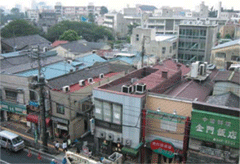 --
--Tokyo is one of the world's leading major cities with a population numbering several tens of millions. There is something in Tokyo that sets it apart from the many other cities in Japan, in both quality and quantity. In Tokyo, there are many small houses.
--The existence of so many detached houses in a major city the size of Tokyo is unparalleled throughout the world. In London, Paris and New York, living in the center of the city means living in collective housing, or, in other words, apartments.
--Overcrowded urban housing was a serious social problem that arose out of the Industrial Revolution beginning at the end of the 18th century. Housing had not been established for people who migrated from the countryside to the city to join the urban workforce, and the development of slums with poor living conditions in cities like London is well known. The suburban residential area typified by Sir Ebenezer Howard's "Garden Cities" was one of the methods devised to solve this problem. Another method took the form of high-density collective housing within the city.
--The so-called separation of home and workplace is taken for granted by today's city dwellers. However, it is actually a concept that the modern urban lifestyle has spawned since the Industrial Revolution. Before then, people working in agriculture lived without any separation between their fields and their houses. Even in cities, it was normal until early modern times for trade to take place in front of a family-owned shop while the family lived in the back. Today's suburban living was born out of people's desire to work efficiently together in the city while living comfortably in the leafy suburbs with their families. This concept is only about 100 years old. The idea of living comfortably in the suburbs may appear to be completely unrelated to cities, and have its own raison d'etre which is nothing to do with metropolises. However, suburban dwellings developed to complement the growth of major cities. Moreover, the suburbs developed because of overcrowding in urban areas and the inability to secure enough space for everyone to live. In addition, due to the problems of air pollution and deterioration of public safety, the city was no longer suitable as a living environment.
 ---
---
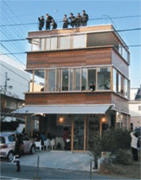 ---
---
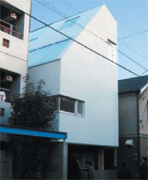 --
--The concept of suburban housing originated in Garden Cities of To-Morrow (1894) by Sir Howard. Public transport systems, including trains and subways, stretched out from the city center, there was a balanced distribution of houses and greenery in systematically subdivided blocks, and the churches, public offices and shops considered necessary to the community were established. This type of suburban residential area came to be widely experimented with not only in the United Kingdom but also all over Europe and even in the United States. It was also introduced into Japan at the beginning of the 20th century. As its name suggests, Denen-Chofu, a high-class residential area of Tokyo's Chofu district in Ota Ward ("Denen" literally means "garden suburb"), is an early example modeled after the "garden city."
--A large amount of collective housing, another solution to the problem of urban overcrowding, was also constructed around the world right through the last century, and, along with the office building, it is the building type that symbolizes the 20th century. In collective housing, the residents share the corridors, the land area, including gardens, and overall building, except for the living spaces of individual households. As such, it has extremely communal and social characters. In particular, communal housing based on socialist principles was researched enthusiastically in the Soviet Union after the 1917 revolution. The communal housing concept culminated in a project in which private rooms were minimized and kitchens and other living spaces were shared. Such communal housing in socialist countries continued to fascinate planners in other countries, both as an ideology and as a kind of dream.
--A large amount of collective housing has been built in Japan as well as other countries over the past century. Although much collective housing was built in city centers before World War II and for a while after the war, the majority of collective housing has been built in the suburbs since then. This is because in Tokyo there has been a clear distinction between the city center as a place for business and commerce and the suburbs as a place for living, unlike other countries where it is assumed that people who work in the city live there. The government and public institutions have adopted policies that underpin this distinction, and the people have also accepted this design as being self-evident.
--As seen above, with an inevitable concentration of the population in cities since modern times, the sprawling expansion of residential areas into the suburbs and vertical efficiency in the form of collective housing within the city have been experimented with as solutions. In this situation, there has been little enthusiasm for living in the center of Tokyo in the past, and large amounts of collective housing have not been constructed there. However, a very strange and curious result of this trend has been the recent boom in architect-designed detached houses in the city. So what does this mean? Thus far, we have prefaced the main theme of this article - why detached houses are now appearing in the center of Tokyo. Now let's examine this housing boom more closely.
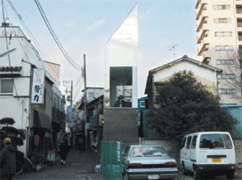 ---
---
 --
--In an easy-to-identify phenomenon, it has become fairly common over the past few years for magazines to target men in their 30s and 40s with special editions featuring small houses, and magazines with photos of these kinds of houses on their front covers adorn the counters of many bookstores. Individual houses and their architects are featured together with articles on fashion, cuisine and art in feature stories that run to several tens of pages, and, in fact, magazine sales apparently rise when they carry these special editions. The general image of architects, not only in Japan but also around the world, is that they are devoted to designing office buildings, cultural facilities and large mansions. However, recently, the threshold for architects has dropped, and it is no longer rare for salaried employees on very average wages in their thirties to commission an architect for their own residences. Indeed, there has been a boom. In Japan, the phrase "i-shoku-ju" means clothing (i), food (shoku) and shelter (ju). The idea that they form the foundation of life has been around for a long time, but there has been little interest in the quality of shelter until now. In the past, there was an expression adopted from overseas that ridiculed Japanese homes as "rabbit hutches." The expression did not only indicate a problem with size but was also directed at a qualitative poverty. For the current generation in Japan, this has translated into a boom in interior design and furniture in the first decade of the 21st century following the fashion boom symbolized by designer brands in the 1980s and the boom in cuisine in the 1990s. Higher quality has been demanded in clothing, food and shelter in that order. People's desire to fill their spaces with furniture and goods that they like was not seen in the previous generation. An extension of this is the desire that people want to live in spaces that they like and the motivation to commission architects to build these spaces. Rather than harboring the illusion of a detached dream home in the suburbs, the sense of realism about having a small house that is customized to a person's own tastes and convenient for city living, despite its size, is also at work.
--On the other hand, looking at the boom in small houses from the design side of the architect, current demand for construction from both the public and private sectors has slumped due to the prolonged economic recession, leaving architects to express their abilities in residential work. This has become the architect's last bastion. For younger architects in their thirties and forties, small houses are their arena of professional activity, and they have actually produced a succession of creative works.
--The Japanese design world is quite unique compared to other countries because it has consistently produced breakthroughs in the residential area since the postwar era. As shown above, there has been hardly any demand for new detached houses in the cities outside of Japan. The majority of houses featured in magazines are built in the suburbs, and many of them are weekend houses rather than a principal residence. Meanwhile, it is the norm in Japan for architects to begin their careers in residential design. For example, Ando Tadao and Ito Toyoo, who are both now active on the global stage, only had the opportunity to design houses for the first 10 years of their careers, and the same is true for other architects. Moreover, public sector construction in Japan is clearly based on an architect's record with commissions finally coming when the architect reaches his or her 50s. The situation is significantly different from countries such as the Netherlands, where architects can handle public sector design as soon as they set up their businesses. Without opportunities to fully utilize their excess energy and talents, young Japanese architects concentrate their skills on small houses. It is a society that tolerates many variegated forms of expression, and with the sophistication of Japan's construction technology, it has led to the appearance of creative houses that are inconceivable in other countries.
--Tracing the history of small houses and urban housing in Japan, we see that directly after the war in the early 1950s, the expression "minimal housing" came into existence. The social environment after the war demanded even smaller houses because materials were in short supply, and there was a need to supply a large volume of housing in the shortages of the postwar period. In this situation, architects showed the world how they could build better houses in limited spaces. The "vertical minimal housing" by Ikebe Kiyoshi in 1950 was two stories with 47 square meter of floor space. It was full of ingenuity that realized a specific image of how to live in the house. In 1952 Masuzawa Makoto created his own residence, which was a mere 30 square meter. The year before last, it was rebuilt using the name "30 square meter house" and is actually inhabited. Later, the "Tower House" built by Azuma Takamitsu in 1967 was a decisive forerunner for the urban housing that followed it. The house was the architect's own residence built on a pentagonal block of only 20 square meter with one floor underground and five floors above ground, and both the interior and exterior were exposed concrete. Inside, care was taken to enrich life right down to the last detail, including the stairwell and the way the windows open, and the architect himself now lives in it with his family. The house was built in between the 1964 Tokyo Olympics and the 1970 World Expo in Osaka, right in the middle of Japan's high-growth era following the period of postwar reconstruction. Tokyo was also undergoing a major transformation to a city full of life. The trend of living in detached houses in the suburbs was established almost in proportion to this. However, Azuma had a strong preference for living in the city and stated that he wanted to live in a house designed to his own specifications however small. The Yoyogi Olympic Pool at the National Gymnasium Complex, an international masterpiece designed by Tange Kenzo and completed in 1964, is very close to this house. This was an era when architects did indeed have a heroic role in society. However, the expression of an architect's worth in the creation of a small house rather than monumental buildings was a conversely radical stance considering the contemporary background. In addition, the fact that the architect himself lived in the house, which is of a size that seems uninhabitable, and proved the potential for urban housing meant that the house became an inspiration for urban housing up to the present day.
 ---
---
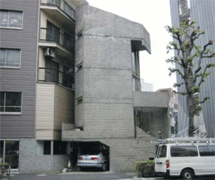 --
--The 1970s and 1980s were the true golden age for urban housing. A magazine entitled Toshi Jutaku (Urban Housing) came into being, giving strong support to the trend. Although the magazine regrettably ceased publication in the second half of the 1980s, it still has a mythical influence and is frequently spoken of. In this period, many architects created residential masterpieces and made deep inquiries into housing. Shinohara Kazuo is the architect who had a decisive influence on the next generation, and his career was almost entirely in residential work. He declared that "housing is art" and demonstrated the possibilities of aesthetic houses as opposed to houses that receive accolades due to their usability. With the expression "embedding the city in the house," Hara Hiroshi turned inside out the generally accepted concept of the "house inside the city." He publicized the concept of the "city inside the small house," and in turn the "universe inside the small house," which indicated the unlimited potential of the house. The house of Ando Tadao, mentioned at the beginning of this article, was built in 1976, and there are many other notable houses created during this era, as well. It was during this period that the many challenges of residential work arose. It became one of the autonomous genres in Japanese architecture and was introduced overseas as an extremely creative, unique movement.
--Recently, there has been another housing boom as I explained earlier. As architects are unable to find a basic direction due to the prolonged economic recession, it appears that they are seeking unrestricted free expression instead. In an era of restrictions, they present animation in their work as if to blow away the situation. However, there are, of course, aspects of this boom that I do not agree with, and there are also various problems.
--For example, these houses may be small, but they have received ample attention from architects. The way that care is given right down to the very corners of such tiny houses brings to mind the Japanese tea ceremony house. Instead of being devoted to large buildings, the architect's energy is concentrated on creating a tiny universe. Considerable time and labor is expended on the design of details, and in some cases, great value has been given to a small and meager thing. There is no room for modern rationality here, which makes it a problem. From the economic perspective, when people are crowded together on the world's most expensive land, each person can access an extremely small amount of land. This is purely an economic problem, but the labor of the architect that is poured into a tiny house built on a tiny piece of land is completely contrary to rationality. Even if the architect becomes popular in residential work, he/she does not benefit economically. But for this very reason, architects may simply be trying to reflect their own dreams in houses.
--Moreover, however devoted architects are to creating houses, the number of houses they are involved in is tiny when considering the total number of houses built in Japan. Naturally, their influence will not be great. Although large sections of the mass media are now covering this area, this coverage is "popularization," to put it plainly, and qualitative dilution is inevitable. Of course it is desirable if many people have an interest in houses and interior design, but it is a shame that it is merely a superficial trend.
--In any event, the current situation makes it easy for people who are looking for a house to commission an architect, and it provides an opportunity for architects to display their skills. More assessment will be required to determine if a new culture of living space is maturing in Japan.
('Journal of Japanese Trade & Insudtry', July/August 2003)

 ---
---
 ---
---

 ---
---

 ---
---
